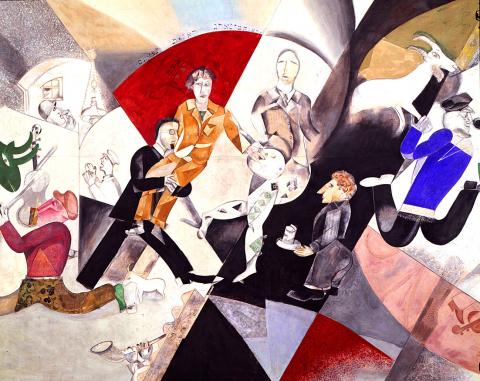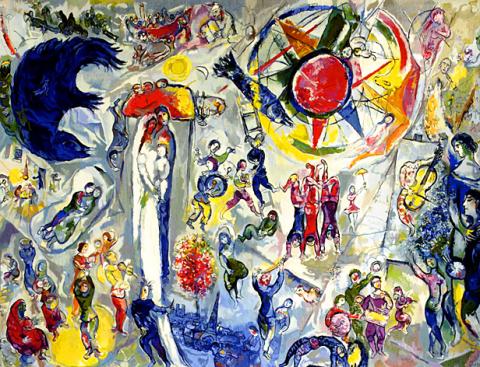Marc Chagall slept here. Did you know?
Rik Rydant, for one, had heard only rumors. Rydant, 70, a retired teacher who has lived in this Catskill hamlet since 1968, considers himself a walking history buff. “I can’t even stand myself sometimes,” he said recently.
So it nagged at him not to know something about this community of under 300 households. Was it true that for two years in the 1940s, after escaping the Holocaust in Europe, one of the titans of modern art had lived right here in this former canal town?

Photo: BLOOMBERG
“It was always just a rumor,” Rydant said. “Did he rent? Did he own the place?”
Rydant infected a neighbor, Gary Ferdman, who had also heard the rumors.
The fruits of their curiosity — let us not say obsession — are now on display in a converted chapel in town. The exhibition, Chagall in High Falls, has united visitors and residents, who do not always mix, Rydant said. Its opening celebration last month drew close to 200 people.

Photo: Bloomberg
“People fell down when they heard Marc Chagall lived in High Falls,” Rydant said. “Locals kind of knew a little about him, but not much. They knew he was living with a younger woman, they knew he was a painter, but they never saw much of his work.”
The exhibition is what Chagall, who spoke largely Yiddish in the Catskills, might have called haimish, which is to say, homey: eight reproductions of paintings he finished in High Falls, as well as 40 or so photographs and documents, including pages from the artist’s FBI file detailing his pacifist or left-wing sympathies. The show shares space with a permanent exhibition on the hamlet’s other claim to posterity, the Delaware and Hudson Canal.
“If we did a show like this in New York City, they’d throw us in the East River,” Rydant said. “But we have the story of Marc Chagall’s life in High Falls to a greater degree than anyone ever had it, and we put it all together.”
The show reflects the efforts of seven local residents to uncover a legacy that has received little attention from scholars. Also, each put in several hundred US dollars to get it up.
“All kudos to the folks there who took a local issue and ran with it,” said Susan Tumarkin Goodman, senior curator of the Jewish Museum in Manhattan, who is organizing a major exhibition of Chagall’s work during World War II and his exile in the US. “They put this era in the history. They know more than anybody else. It shows what you can do if you have passion.”
Chagall, who was born in Belarus and fled to the US in 1941, lived in High Falls from April 1946 to August 1948, during which time he completed more than 90 paintings. In town he rode his bicycle and tried to barter paintings for local services, Rydant said.
“A Dr Shay turned down a painting, saying, ‘Oh no, I want the 15 bucks,”’ Rydant said. “There’s a rumor that Chagall left drawings on the walls of his house, behind the wallpaper, but we don’t know.”
Of such rumors, of course, can come
many things, especially in a town dependent on tourism.
Maribeth Lee, who lives in Chagall’s former house, a blue wood-frame number just up the street from the museum, hopes the new attention to Chagall might attract a buyer for the house, possibly the Ulster County Historical Society. In the meantime, Lee said she had had to deal with interest of a different kind.
“For years maybe 10 people a summer would knock on the door,” she said.
Now it’s three or four visitors a day.
“My son will tell me, ‘There were people on the yard.’ I can’t stop them taking pictures,” she said. “It’s when they come on the property.”
Ferdman, who does fund-raising and development work for the nonprofit organization Common Cause, said the exhibit was a way to excavate the buried history of Virginia Haggard, Chagall’s partner in High Falls, who has been overshadowed by his two wives. Haggard, the great-niece of the British adventure writer H. Rider Haggard, became Chagall’s lover after the death of his first wife, Bella, in 1944, and the couple moved to High Falls from Riverside Drive in part because she was pregnant, Ferdman said.
The couple left for France two years later and never returned, though Chagall applied twice for visas but was rejected because of his political affiliations. Chagall died in France in 1985. (Exactly how they settled on High Falls is unclear, though Chagall had visited the area before, with or without Haggard. There exists a 1945 letter he wrote in Yiddish from the Beaver Lake House, an inn in nearby Krumville.)
“That whole period has been buried because Virginia has been buried,” Ferdman said. “Chagall lived with her for seven years, and she bore his only son, but she’s not even mentioned in his biographies until 1978.”
For the exhibit’s seven creators, some of whom are connected with the tourist trade, the challenge now is to keep Chagall’s presence in town after the museum closes for the season at the end of this month. They are thinking big: a Cafe Chagall, a documentary.
“We’ve had people come from Philadelphia and New York City just to see the show,” said Tecia Poulas, a real estate agent.
For Chagall’s granddaughter, Bella Meyer, 56, who runs a flower shop in Manhattan, the exhibit was a chance to connect with family history and with the area. Meyer spoke at the opening and visited her grandfather’s house for the first time, though Lee did not let her take photographs.
“After this event, I felt more than ever how sad a period it was for him,” Meyer said. “Even though the area seems idyllic, it was like a hiding place or refuge just to find his inner self.”

In the March 9 edition of the Taipei Times a piece by Ninon Godefroy ran with the headine “The quiet, gentle rhythm of Taiwan.” It started with the line “Taiwan is a small, humble place. There is no Eiffel Tower, no pyramids — no singular attraction that draws the world’s attention.” I laughed out loud at that. This was out of no disrespect for the author or the piece, which made some interesting analogies and good points about how both Din Tai Fung’s and Taiwan Semiconductor Manufacturing Co’s (TSMC, 台積電) meticulous attention to detail and quality are not quite up to

April 21 to April 27 Hsieh Er’s (謝娥) political fortunes were rising fast after she got out of jail and joined the Chinese Nationalist Party (KMT) in December 1945. Not only did she hold key positions in various committees, she was elected the only woman on the Taipei City Council and headed to Nanjing in 1946 as the sole Taiwanese female representative to the National Constituent Assembly. With the support of first lady Soong May-ling (宋美齡), she started the Taipei Women’s Association and Taiwan Provincial Women’s Association, where she

It is one of the more remarkable facts of Taiwan history that it was never occupied or claimed by any of the numerous kingdoms of southern China — Han or otherwise — that lay just across the water from it. None of their brilliant ministers ever discovered that Taiwan was a “core interest” of the state whose annexation was “inevitable.” As Paul Kua notes in an excellent monograph laying out how the Portuguese gave Taiwan the name “Formosa,” the first Europeans to express an interest in occupying Taiwan were the Spanish. Tonio Andrade in his seminal work, How Taiwan Became Chinese,

Mongolian influencer Anudari Daarya looks effortlessly glamorous and carefree in her social media posts — but the classically trained pianist’s road to acceptance as a transgender artist has been anything but easy. She is one of a growing number of Mongolian LGBTQ youth challenging stereotypes and fighting for acceptance through media representation in the socially conservative country. LGBTQ Mongolians often hide their identities from their employers and colleagues for fear of discrimination, with a survey by the non-profit LGBT Centre Mongolia showing that only 20 percent of people felt comfortable coming out at work. Daarya, 25, said she has faced discrimination since she